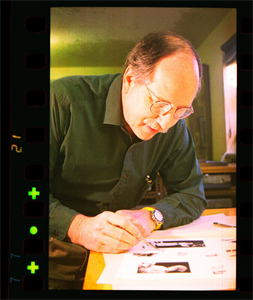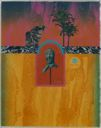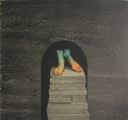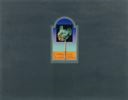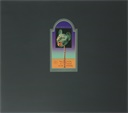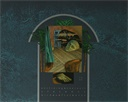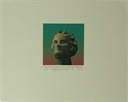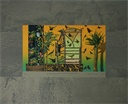(Wilford) Wayne Kimball Jr.
(Salt Lake City, UT, 1943 - )
Utah native W. Wayne Kimball was born on 15 July 1943 in Salt Lake City. He holds a Bachelor of Arts degree from the College of Southern Utah, Cedar City, and a Master of Fine Arts degree from the University of Arizona, Tucson. He also is certified as a Tamarind Master Printer from the Tamarind Institute, University of New Mexico, Albuquerque. Kimball's teaching experience includes a number of faculty positions at universities in New Mexico, Wisconsin, California, Texas, Arizona, and Utah. He was a Professor in the Department of Visual Arts at Brigham Young University in Provo. Wayne Kimball's interest in lithographs can be traced back to his childhood exposure to small-scale art reproductions in books and magazines. Kimball prefers the intimacy of small works utilizing smooth tonal gradations and intricate drawings. Lithography combines color intensity, wash textures, and crayon tones in a manner unlike other media. Although Kimball's work is often considered symbolic or metaphoric in nature, the artist prefers that it be viewed as a "situational surrogate" in which the viewer's own assumptions are used to interpret the meaning and content of the work. Often the range of subjects and their orientation produce unexpected associations within the picture while their compilation, arrangement, and execution "combine to hint at symbolic interpretations." Kimball has had over 40 solo exhibitions at various galleries, museums, and educational institutions. He has also exhibited at over 250 regional, national, and international juried and invitational shows. His work can be found in more than 55 permanent institutional collections and this Fall, Kimball will have a one-man show that will travel the state of North Dakota. As an individual and as an artist, Wayne Kimball’s artist’s statement best conveys who he is. Wayne Kimball is a right-handed Caucasian male artisan who makes lithographs* in a subterranean chamber situated near the mouth of Battlecreek Canyon. Although he does not hear very well, he does wear bifocaled spectacles to improve his visual acuity. He showers early every morning, and has a day job impersonating an art professor at Brigham Young University. He admires artists who have the facility and restraint to deal with observable forms by implication: suggesting, hinting or otherwise providing visual clues (rather than explicitly rendering everything) thereby allowing the viewer to participate in the art-making process by using his or her imagination to complete the pictures. Despite the admiration, however, Kimball is compulsively self-indulgent in the pleasure of making crayon tones and tusche washes on slabs of Bavarian limestone and plates of grained aluminum. He is unable to resist working images to a level of finish that denies the viewer the right (or rite) of optical completion, although he hopes to challenge the viewer to make psychological completion. To make things worse, he prefers small, intimate formats over larger ones (which rubs against much of what he was taught in graduate school by professors who thought in terms of Abstract Expressionist and Pop issues). His idiosyncratic preferences for small scale and high finish seem to derive in part from a boyhood of viewing art in reproduced form in books and magazines rather than in actuality on gallery and museum walls. That perception of art may well have something to do with his choice to employ thin veils of ink printed on paper rather than paint on canvas, drawing material(s) on paper or fresco on damp plaster walls. Kimball’s most recent art includes actual collages. Although somewhat different from his lithographs (less representational and more symbolic), people have told him they recognize the works as his. He has found it satisfying both to create the collages and then also to use some of the formal materials in recent prints. Museum trade, SMA 1995.046Kimball engages the viewer's attention and imparts content by "selecting subjects (or pieces of subjects) which, when put together (or, in fact, when isolated), suggest meanings beyond themselves—either in the hope they will be perceived as some kind of metaphor, puzzle, or riddle or dilemma to which contemplation will surely supply an answer, or as objects imbued with disguised, obscure or cryptic meanings which may only be discerned during periods of sleep or other less-than-conscious states." Influenced by Northern Renaissance paintings and Islamic and Indian miniatures, Kimball’s pieces often include inscriptions and classical or medieval iconography imagery because he is enchanted by art from cultures where calligraphy is prized, such as in Islamic art. He likes being invited to make a verbal connection to the art and hopes the text creates speculation in the viewer,which provides more substance for interpretation. Kimball's lithograph Homo Barbatus Cum Tanto Dolore Capitis, a mixture of classical and modern images set against a marble-like background, depicts a disembodied man with classical features (head & feet) holding up his hands to illustrate the size of his headache. The head is from a 17th Century Laocoön group—priests who tried to warn Troy against the Trojan Horse. The hands are industrial gloves from a catalog of scientific materials, and the feet are from a book of 19th Century engravings. The Latin title is translated as I Have A Headache This Big, and the man's face clearly expresses his physical suffering. Although he doesn’t expect viewers to understand the Latin, Kimball himself enjoys the fact that translating his idea into Latin and then back results in two rather different titles.
(Salt Lake City, UT, 1943 - )
Utah native W. Wayne Kimball was born on 15 July 1943 in Salt Lake City. He holds a Bachelor of Arts degree from the College of Southern Utah, Cedar City, and a Master of Fine Arts degree from the University of Arizona, Tucson. He also is certified as a Tamarind Master Printer from the Tamarind Institute, University of New Mexico, Albuquerque. Kimball's teaching experience includes a number of faculty positions at universities in New Mexico, Wisconsin, California, Texas, Arizona, and Utah. He was a Professor in the Department of Visual Arts at Brigham Young University in Provo. Wayne Kimball's interest in lithographs can be traced back to his childhood exposure to small-scale art reproductions in books and magazines. Kimball prefers the intimacy of small works utilizing smooth tonal gradations and intricate drawings. Lithography combines color intensity, wash textures, and crayon tones in a manner unlike other media. Although Kimball's work is often considered symbolic or metaphoric in nature, the artist prefers that it be viewed as a "situational surrogate" in which the viewer's own assumptions are used to interpret the meaning and content of the work. Often the range of subjects and their orientation produce unexpected associations within the picture while their compilation, arrangement, and execution "combine to hint at symbolic interpretations." Kimball has had over 40 solo exhibitions at various galleries, museums, and educational institutions. He has also exhibited at over 250 regional, national, and international juried and invitational shows. His work can be found in more than 55 permanent institutional collections and this Fall, Kimball will have a one-man show that will travel the state of North Dakota. As an individual and as an artist, Wayne Kimball’s artist’s statement best conveys who he is. Wayne Kimball is a right-handed Caucasian male artisan who makes lithographs* in a subterranean chamber situated near the mouth of Battlecreek Canyon. Although he does not hear very well, he does wear bifocaled spectacles to improve his visual acuity. He showers early every morning, and has a day job impersonating an art professor at Brigham Young University. He admires artists who have the facility and restraint to deal with observable forms by implication: suggesting, hinting or otherwise providing visual clues (rather than explicitly rendering everything) thereby allowing the viewer to participate in the art-making process by using his or her imagination to complete the pictures. Despite the admiration, however, Kimball is compulsively self-indulgent in the pleasure of making crayon tones and tusche washes on slabs of Bavarian limestone and plates of grained aluminum. He is unable to resist working images to a level of finish that denies the viewer the right (or rite) of optical completion, although he hopes to challenge the viewer to make psychological completion. To make things worse, he prefers small, intimate formats over larger ones (which rubs against much of what he was taught in graduate school by professors who thought in terms of Abstract Expressionist and Pop issues). His idiosyncratic preferences for small scale and high finish seem to derive in part from a boyhood of viewing art in reproduced form in books and magazines rather than in actuality on gallery and museum walls. That perception of art may well have something to do with his choice to employ thin veils of ink printed on paper rather than paint on canvas, drawing material(s) on paper or fresco on damp plaster walls. Kimball’s most recent art includes actual collages. Although somewhat different from his lithographs (less representational and more symbolic), people have told him they recognize the works as his. He has found it satisfying both to create the collages and then also to use some of the formal materials in recent prints. Museum trade, SMA 1995.046Kimball engages the viewer's attention and imparts content by "selecting subjects (or pieces of subjects) which, when put together (or, in fact, when isolated), suggest meanings beyond themselves—either in the hope they will be perceived as some kind of metaphor, puzzle, or riddle or dilemma to which contemplation will surely supply an answer, or as objects imbued with disguised, obscure or cryptic meanings which may only be discerned during periods of sleep or other less-than-conscious states." Influenced by Northern Renaissance paintings and Islamic and Indian miniatures, Kimball’s pieces often include inscriptions and classical or medieval iconography imagery because he is enchanted by art from cultures where calligraphy is prized, such as in Islamic art. He likes being invited to make a verbal connection to the art and hopes the text creates speculation in the viewer,which provides more substance for interpretation. Kimball's lithograph Homo Barbatus Cum Tanto Dolore Capitis, a mixture of classical and modern images set against a marble-like background, depicts a disembodied man with classical features (head & feet) holding up his hands to illustrate the size of his headache. The head is from a 17th Century Laocoön group—priests who tried to warn Troy against the Trojan Horse. The hands are industrial gloves from a catalog of scientific materials, and the feet are from a book of 19th Century engravings. The Latin title is translated as I Have A Headache This Big, and the man's face clearly expresses his physical suffering. Although he doesn’t expect viewers to understand the Latin, Kimball himself enjoys the fact that translating his idea into Latin and then back results in two rather different titles.
Artist Objects
